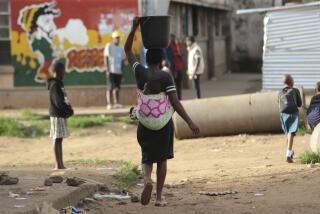U.N. Finds Poorest Worse Off
- Share via
UNITED NATIONS — An annual U.N. report on development released Wednesday shows that living standards in parts of the former Soviet Union and in sub-Saharan Africa have been declining steadily even as conditions elsewhere in the world have largely improved.
Norway tops the index, which seeks to assess nations’ economic development, dignity and quality of life. The United States is ranked 10th. Iraq, Liberia and Afghanistan are not included because of the lack of reliable statistics, and Liechtenstein is absent because it did not provide income information about its generally wealthy citizens. Niger is at the bottom of the list.
“The index shows in clear, cold numbers that many countries are not only failing to progress, but are actually slipping backward, and they will continue on that downhill path unless the international community steps in to help with more resources and new policies,” said Kevin Watkins, the main author of the report.
The U.N. delivered the survey to the New York missions of its 191 member states Wednesday and urged national leaders, who are to gather at the world body next week for a summit on development and restructuring the United Nations, to act to stop the slide into devastation.
At the U.N.’s Millennium Summit in 2000, heads of state pledged to change global aid, trade and security policies to help halve the poverty rates in the poorest countries by 2015, among other development goals. Many of those promises have yet to be fulfilled.
“The world has the knowledge, resources and technology to end extreme poverty, but time is running out,” said Kemal Dervis, administrator of the U.N. Development Program, which produced the report.
Twelve of the 18 countries shown to be regressing are in sub-Saharan Africa. One of three people in the region lives in a nation that is worse off than it was in 1990, when the U.N. first began to track standard of living statistics.
The decline has been sparked mainly by the HIV/AIDS pandemic, contributing to South Africa’s fall by 35 places on the list since 1990 and Botswana’s drop by 21 places.
Russia and most of its neighbors in the former Soviet Union continue to lag substantially behind Central and Western Europe, though infusions of foreign investment and a boom in Caspian Sea oil have helped slow the sharp downward slide that began with the Soviet collapse in 1991.
“Overall, the region has improved because economic growth is very strong,” Kalman Mizsei, an assistant U.N. secretary-general and the Development Program’s regional director for Europe and the Commonwealth of Independent States, said in a telephone interview.
Yet a third of the 18 countries that have fared demonstrably worse in terms of the economy, education and the mortality rate since 1990 are former Soviet republics. Tajikistan fell 21 places; Ukraine, 17; and Russia, 15.
A worrying decline in life expectancy for men and skyrocketing rates of HIV/AIDS were among the factors.
Ukraine has one of the fastest-growing rates of HIV infection in the world, with Russia a close second. The decline also reflected high levels of corruption in nations from Russia to Central Asia.
Although the index does not attempt to measure the level of democracy, Mizsei said, “there is a strong historical correlation between open societies and honest societies and their economic progress. So over time, of course, this matters a great deal.”
Poverty rates have begun to fall broadly across many of the former Soviet states, including Kazakhstan, Armenia and Azerbaijan, and some of these economies have been among the world’s fastest growing in recent years. Economic growth is just one element of the index, which includes elements such as gender empowerment, health-care and education expenditure and access to technology.
Overall, the global trend has been one of progress. People in developing countries have on average become healthier, better educated and less impoverished in the last 15 years, the report says. They are also far more likely to live in a multi-party democracy, it adds.
Life expectancy in developing countries has increased by two years overall and 2 million fewer children die annually.
Meanwhile, 30 million fewer children are out of school and more than 100 million people have escaped extreme poverty.
The report also highlights development success stories, such as Vietnam, which has reduced the number of people who live on less than $1 a day by half and reduced child mortality rates over the last decade. Bangladesh, China and Uganda also made significant overall gains.
The report is slightly unconventional in that it does not only measure per capita income and basic needs, but also tries to gauge human freedom, dignity and the role of people in development.
The U.N. development agency has programs in 166 countries.
Farley reported from the United Nations and Murphy from Moscow. The UNDP report is available online at: https://hdr.undp.org/reports/global/2005/
More to Read
Sign up for Essential California
The most important California stories and recommendations in your inbox every morning.
You may occasionally receive promotional content from the Los Angeles Times.










